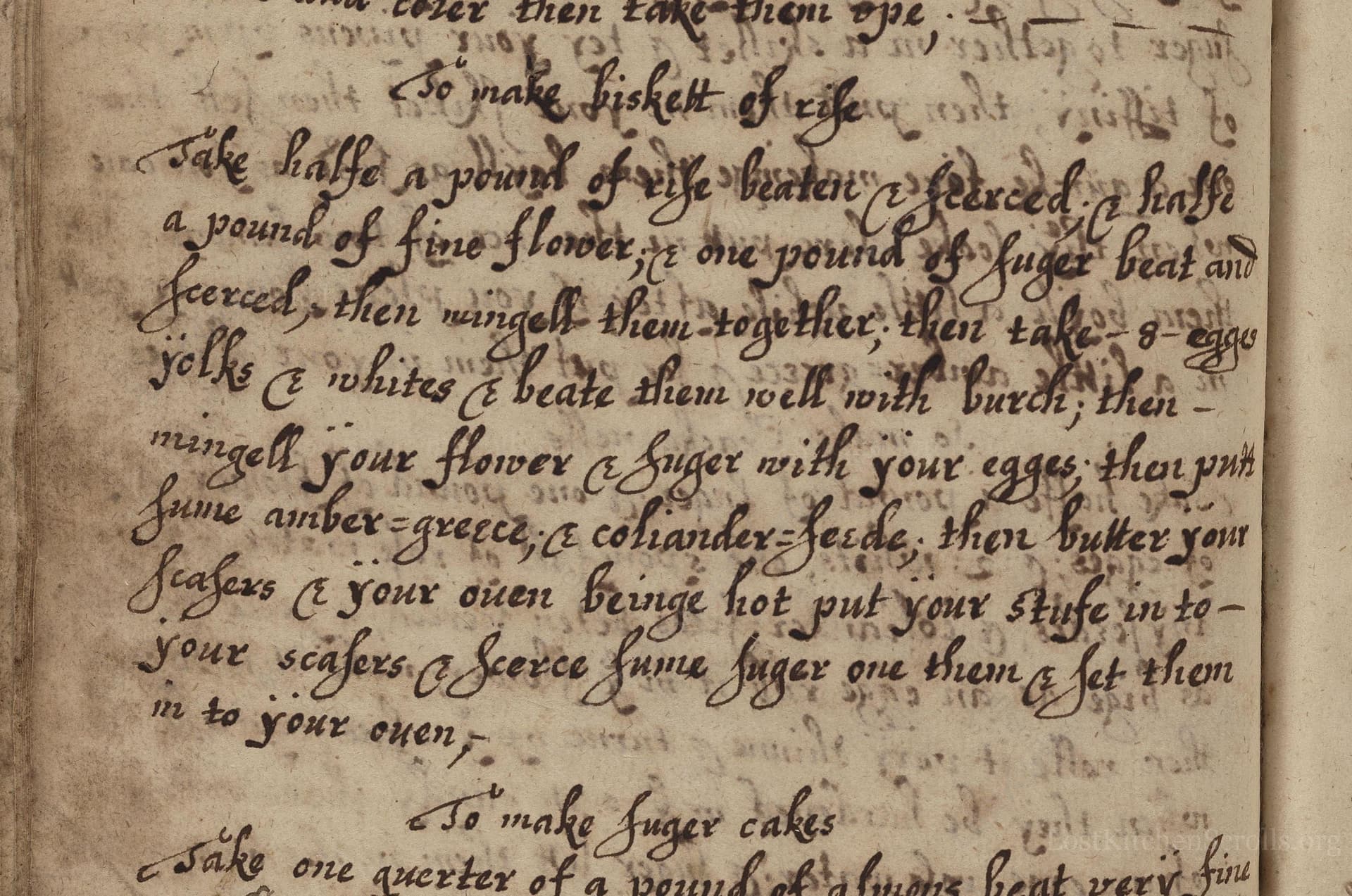To Make Biskett Of Rise
From the treasured pages of Receipt book of Margaret Baker
Written by Margaret Baker

To Make Biskett Of Rise
"Take halfe a pound of rise beaten & serced, & halfe a pound of fine flower, & one pound of suger beat and serced, then mingell them together, then take 8 egges yolks & whites & beate them well with burch, then mingell your flower & suger with your egges, then put in sume amber-greece, & coriander-seede, then butterr your scafers & your oven beinge hot put your stufe in to your scafers & serce sume suger one them & set them in to your oven."
Note on the Original Text
This manuscript recipe is constructed in the direct, run-on prose customary of the 17th century. Spelling is variable ('flower' for flour, 'serced' for sifted, 'mingell' for mingle/mix, 'egges' for eggs). There is no list of ingredients as in modern recipes; rather, quantities and components are woven into the narrative, reflecting the assumption that the reader has kitchen skill and local knowledge. Some terms may trip up the modern cook: 'amber-greece' is ambergris, used here as a perfume; 'scafers' are pans or trays. Instructions are brief and improvisational—timings, oven temperatures, and details are inferred by experience.

Title
Receipt book of Margaret Baker (1675)
You can also click the book image above to peruse the original tome
Writer
Margaret Baker
Era
1675
Publisher
Unknown
Background
Step into the 17th-century kitchen with Margaret Baker, whose delectable recipes and culinary wisdom promise a feast of traditional flavors and genteel charms. A delightful collection for those who savor history as much as fine food.
Kindly made available by
Folger Shakespeare Library
This recipe hails from the late 17th century, attributed to Margaret Baker circa 1675. 'Bisquett of rise' reflects a time when rice was known in English kitchens but still something of a luxury, mainly reserved for sweet cakes and medicines. Incorporating 'amber-greece' (ambergris), a costly aromatic, marks this as a bisket fit for the well-to-do—perhaps a treat for special occasions or gatherings where one wished to impress. The recipe also speaks to the transitional moment in English baking: sugar was becoming more common, eggs were abundant, and refined wheat flour available, but rice shows the influence of new ingredients traveling through global trade.

The cook would have used simple, robust tools: a large mortar and pestle or hand-driven mill to grind the rice, wooden sieves to sift both rice and sugar, and a birch-wood whisk or bundle ('burch') to vigorously beat the eggs. Baking would be done in a wood-fired oven—gauging the heat by experience—and the 'scafers' mentioned are shallow baking pans or molds, buttered well to prevent sticking. A simple spoon or spatula would fold the ingredients, and paper or tin sheets might serve as improvisational bakeware.
Prep Time
20 mins
Cook Time
25 mins
Servings
20
We've done our best to adapt this historical recipe for modern kitchens, but some details may still need refinement. We warmly welcome feedback from fellow cooks and culinary historians — your insights support the entire community!
Ingredients
- 8 oz rice (finely ground)
- 8 oz plain flour (wheat)
- 1 lb caster sugar
- 8 large eggs
- Butter (for greasing)
- Pinch ground coriander seeds
- Small pinch edible ambergris (substitute: 1/2 tsp vanilla extract)
- Extra caster sugar (for sprinkling)
Instructions
- To make biscuits of rice, start by finely grinding 8 oz of rice, then sifting it to remove any coarse pieces.
- Combine this with 8 oz of plain wheat flour and 1 lb of caster sugar, also sifted.
- In another bowl, beat together 8 large eggs until frothy and combined well.
- Gently fold the flour, rice, and sugar mixture into the eggs.
- Add a small pinch of ground coriander seed and, if available, a tiny amount (just a pinch) of edible ambergris or, as a substitute, half a teaspoon of vanilla extract for aroma.
- Grease baking molds or sheets with butter, spoon in the mixture, sprinkle a little sugar on top, and bake in a preheated oven at about 350°F until lightly golden.
- Let cool before serving.
Estimated Calories
220 per serving
Cooking Estimates
It takes about 20 minutes to prepare the ingredients, and then you bake for 20 to 25 minutes. Each serving is about 220 calories if you divide the batch into 20 biscuits.
As noted above, we have made our best effort to translate and adapt this historical recipe for modern kitchens, taking into account ingredients nowadays, cooking techniques, measurements, and so on. However, historical recipes often contain assumptions that require interpretation.
We'd love for anyone to help improve these adaptations. Community contributions are highly welcome. If you have suggestions, corrections, or cooking tips based on your experience with this recipe, please share them below.
Join the Discussion
Rate This Recipe

Den Bockfisch In Einer Fleisch Suppen Zu Kochen
This recipe hails from a German manuscript cookbook compiled in 1696, a time whe...

Die Grieß Nudlen Zumachen
This recipe comes from a rather mysterious manuscript cookbook, penned anonymous...

Ein Boudain
This recipe comes from an anonymous German-language manuscript cookbook from 169...

Ein Gesaltzen Citroni
This recipe, dating from 1696, comes from an extensive anonymous German cookbook...
Browse our complete collection of time-honored recipes



